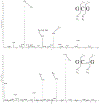Covalent Modification of Amino Acids and Peptides Induced by Ionizing Radiation from an Electron Beam Linear Accelerator Used in Radiotherapy
- PMID: 30849023
- PMCID: PMC6506356
- DOI: 10.1667/RR15288.1
Covalent Modification of Amino Acids and Peptides Induced by Ionizing Radiation from an Electron Beam Linear Accelerator Used in Radiotherapy
Abstract
To identify modifications to amino acids that are directly induced by ionizing radiation, free amino acids and 3-residue peptides were irradiated using a linear accelerator (Linac) radiotherapy device. Mass spectrometry was performed to detail the relative sensitivity to radiation as well as identify covalent, radiation-dependent adducts. The order of reactivity of the 20 common amino acids was generally in agreement with published literature except for His (most reactive of the 20) and Cys (less reactive). Novel and previously identified modifications on the free amino acids were detected. Amino acids were far less reactive when flanked by glycine residues in a tripeptide. Order of reactivity, with GVG most and GEG least, was substantially altered, as were patterns of modification. Radiation reactivity of amino acids is clearly and strongly affected by conversion of the α-amino and α-carboxyl groups to peptide bonds, and the presence of neighboring amino acid residues.
Figures




Similar articles
-
Trajectory control of electron beams using high intensity permanent magnests for linac-adaptable convergent beam radiotherapy.Appl Radiat Isot. 2019 Sep;151:13-18. doi: 10.1016/j.apradiso.2019.05.032. Epub 2019 May 24. Appl Radiat Isot. 2019. PMID: 31153053
-
Covalent adducts of melphalan with free amino acids and a model peptide studied by liquid chromatography/tandem mass spectrometry.Rapid Commun Mass Spectrom. 2016 Mar 30;30(6):719-30. doi: 10.1002/rcm.7489. Rapid Commun Mass Spectrom. 2016. PMID: 26864525
-
Evaluation of a photon and an electron beam of a 6-MV linear accelerator.Med Phys. 1988 Jul-Aug;15(4):525-9. doi: 10.1118/1.596203. Med Phys. 1988. PMID: 3211045
-
Special radiation protection aspects of medical accelerators.Radiat Prot Dosimetry. 2001;96(4):381-92. doi: 10.1093/oxfordjournals.rpd.a006626. Radiat Prot Dosimetry. 2001. PMID: 11843087 Review.
-
Monte Carlo modelling of electron beams from medical accelerators.Phys Med Biol. 1999 Dec;44(12):R157-89. doi: 10.1088/0031-9155/44/12/201. Phys Med Biol. 1999. PMID: 10616140 Review.
Cited by
-
Degradable Hydrogel Microspheres for Drug Delivery: In Vitro Performance and Influence of E-Beam Sterilization.AAPS PharmSciTech. 2025 Jun 4;26(5):162. doi: 10.1208/s12249-025-03144-1. AAPS PharmSciTech. 2025. PMID: 40467991
-
Proteome Damage Inflicted by Ionizing Radiation: Advancing a Theme in the Research of Miroslav Radman.Cells. 2021 Apr 20;10(4):954. doi: 10.3390/cells10040954. Cells. 2021. PMID: 33924085 Free PMC article.
-
Ionizing Radiation-induced Proteomic Oxidation in Escherichia coli.Mol Cell Proteomics. 2020 Aug;19(8):1375-1395. doi: 10.1074/mcp.RA120.002092. Epub 2020 Jun 14. Mol Cell Proteomics. 2020. PMID: 32536603 Free PMC article.
-
Experimental evolution of extremophile resistance to ionizing radiation.Trends Genet. 2021 Sep;37(9):830-845. doi: 10.1016/j.tig.2021.04.011. Epub 2021 Jun 1. Trends Genet. 2021. PMID: 34088512 Free PMC article. Review.
References
Publication types
MeSH terms
Substances
Grants and funding
LinkOut - more resources
Full Text Sources
Other Literature Sources
Medical

